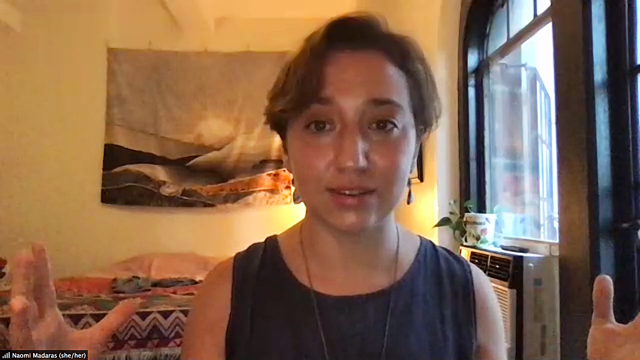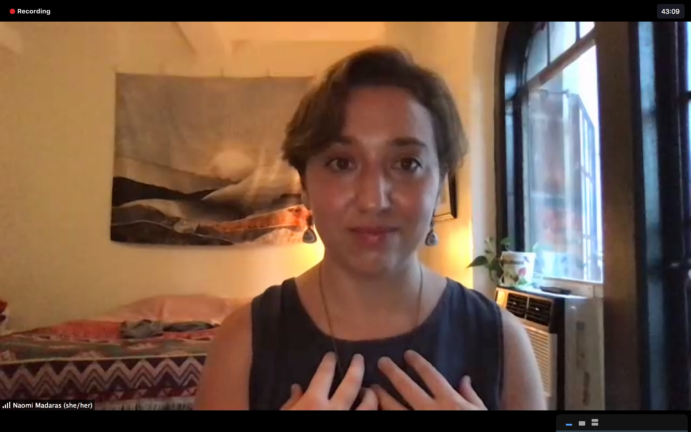
Friday night, July 31, before an audience of 160 people, Naomi Madaras made the case for faith to choose paths that embraced conflict, anger, protest and justice. A Master of Divinity candidate at Union Theological Seminary in New York, Naomi’s clinical training has been in hospitals and nursing homes in New York where she provides spiritual care to patients, families, and staff.
During her 90-minute presentation Naomi offered some Quaker history. She named Quaker engagement in enslaving peoples, noted its white supremacist culture, and detailed Friends’ active engagement in profiting from enslaved labor, managing wealth-generating plantations in Barbados that relied on the labor of enslaved Africans, and participating in slavery and a slave-holding Pennsylvania economy.
The timing of annual sessions in July, and the growth of the Black Lives Matter movement following Police Officer Derek Chauvin’s murder of George Floyd, informed Naomi’s decision to focus her keynote address on conflict.
When I was planning, back in February, I knew I wanted to talk about conflict and anger and how important and turbulent these experiences can be in a Quaker community. As summer unfolded and people continued to rally behind the movement for Black liberation, I realized I wanted to speak more specifically about Abolition.
American Quakers have been known for their work around abolishing slavery. When we look back on our history as Friends there are examples of Friends that responded to the call for abolition, as well as those who resisted because it was too divisive or upsetting. In our current moment, Black, Indigenous and People of Color are calling for the abolition and demilitarization of our police and prison systems. How do Quakers listen to this Abolitionist call today? What can our Faith teach us about the abolitionist work at hand.
Naomi offered Friends space throughout the evening to imagine, reflect, and dream about how the way we think about anger and conflict influences our justice work and our conception of the inner light.
She interspersed her talk with time for query-led reflections. Some of these queries were:
- Reflect upon your earliest memories in learning about Quakers and abolition? What were you taught about Quakers and Slavery?
- Think back on a moment you were angry in Meeting. Describe the encounter and the feelings that came up for you.
- Now describe what you would need to feel supported in your anger or in a conflict. Did you feel that support in the moment you described?
- Think back to your first introduction to Quakerism. How was the Inner Light described to you? I invite you to draw a picture of the Light.
After each period of reflection, people shared their thoughts and feelings in chat text and also by speaking.
Naomi mentioned William Penn and George Fox for their connections with slavery. She characterized Fox as” not exactly silent on slavery” – noting in an email exchange as we finalized this article on her talk that “he focused on missionary work instead of abolition, and assured the governor of Barbados he would not interfere in the institution of slavery.”
Penn on the other hand was an active participant; he used enslaved peoples as labor on his property.
We closed with an examination of the Inner Light. Naomi described Friends’ use of the phrases, “Inward Light, the Seed, the Light of Christ” during the first years of Quakerism. She said that the expressions originated in the first chapter of John, verse nine. It reads “the true light, which enlightens everyone, was coming into the world.”
To early Friends, Naomi said, “this was no metaphor but the real presence of Christ Within. The light signifying more than a singular flame or … fire, for many Friends it served as a beacon, the light shown upon injustices. It taught, directed, clarified and emboldened Friends, revealing profound and distressing truths about ourselves.”
At points in her life, Naomi had envisioned the inner light as a candle-like light, with a quiet, steady, inward-focused and comforting aspect, but in her talk on July 31st she invited Friends into the image of a ferocious light, “a mama-bear type of light. Not small or quavering but bright and crackling with plenty of firewood.”
She noted that “the language of white light can be a sneaky way that white supremacy shows up in our language, by associating lightness with goodness and darkness with evil, but our light is not a white light. It contains multitudes of colors, and it contains darkness and shadows, too. We kindle this light in our communities. Each person brings with them fuel for the fire, whether virtual or in person, and we each have our own private glorious connection to such lights. In community I like to think it becomes a fire. In community, in revolution, in gathering, we unite in a fiery embrace of love and justice.”
Naomi named that while she did not have answers for all the questions sparked by the evening’s queries and the community’s input, she encouraged Friends see the kindled fire as a way to rouse the ‘conscience of the nation’ much as Frederick Douglass did with his many anti-slavery speeches 160 years ago.
As a predominantly white faith community in the US, we as Quakers must listen to witness of Black Friends, we may have questions or disagreements, but we cannot pretend we do not witness the violence of the police state, a violence we purport to resist through our Quaker testimonies. I speak to White Quakers tonight in particular, we have had time to reflect on our past. The ways we were complicit, the ways we rebelled, whether we are long-time members of the Religious Society of Friends or newcomers; we participate in and inherit this history.

Naomi said that she recognized her own ambivalence, and ignorance. She named that there is personal shame, but said it is possible to work with that shame. Abolitionist work is imperfect, and anti-racism work is likewise imperfect. She framed a possible way forward for Friends with this thought: “Each moment of anxiety, though, is an opportunity for growth and opening. In an ideal world our communities would nurture and hold us accountable through these growing pains. We can dream toward this ideal world together.”
Naomi then closed by reading the poem “In Praise of Fire,” by John O’Donohue.